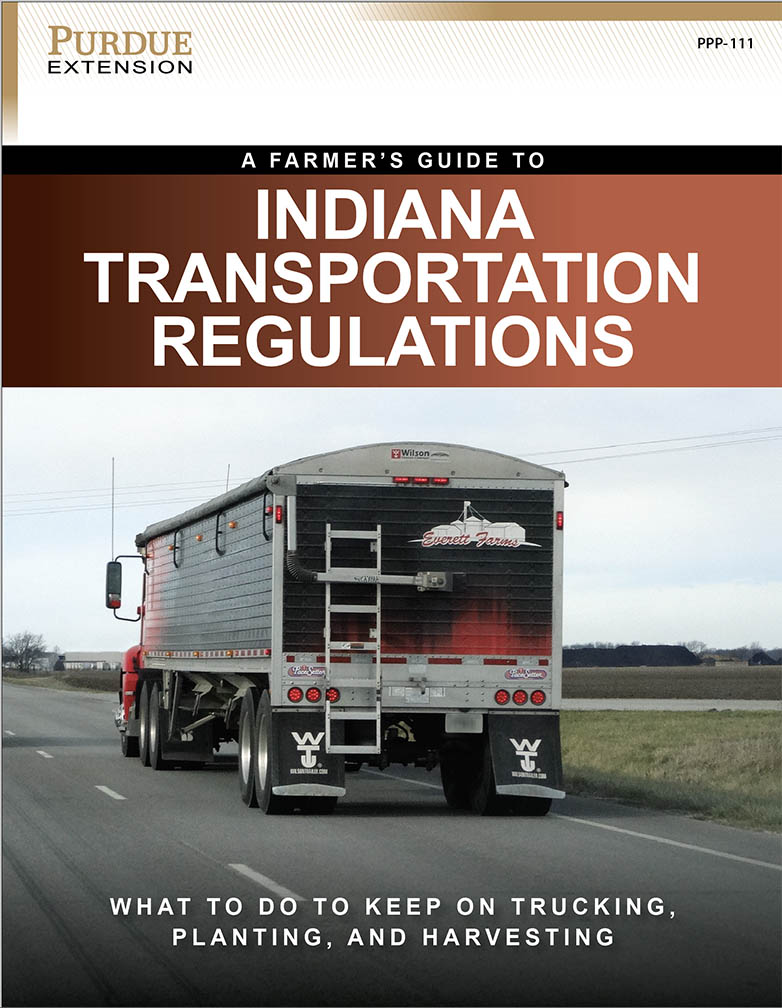
A FARMER’S GUIDE TO INDIANA TRANSPORTATION REGULATIONS, WHAT TO DO TO KEEP ON TRUCKING, PLANTING, AND HARVESTING
Authors
Fred Whitford, Coordinator, Purdue Pesticide Programs
Mike Templeton, President, Surface Transportation Consultant
Brian Drummy, Attorney, Bunger & Robertson
Brent Bible, Indiana Farmer
Daniel Gwin, Indiana Farmer
Cathy Fritz, President, Cathy Fritz Consulting, Inc.
Amy Cornell, Policy Advisor and Counsel, Indiana Farm Bureau
Kevin Leigh Smith, Editor, Purdue Agricultural Communication
What this publication will cover:
- You’re Not Going to Believe What I Saw Today
- Compliance With Transportation Regulations Made Easier
- The Four Types of Carriers
- Appendix 1: Indiana Bridge Law 27
- Appendix 2: Indiana State Police Letter
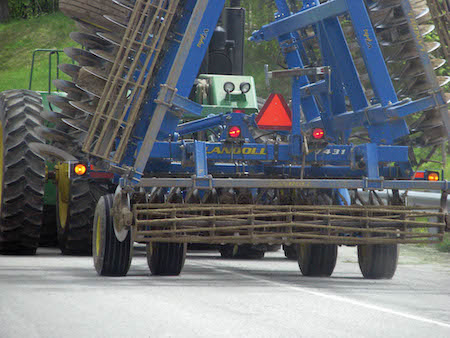
You’re Not Going to Believe What I Saw Today
Every farmer who’s ever driven a tractor or semi-tractor trailer has many stories about what they witnessed from the cab: the motorcycle that passed underneath a high-clearance sprayer, the car that roared past and barely avoided a head-on collision with oncoming traffic; the driver who laid on the horn (as if the tractor could go any faster); the frustrated driver who waved for the tractor to pull over, not caring about the drainage ditches or mailboxes along the shoulder; or the cars that jockeyed in and out of line for position behind a tractor to pass as if they were warming up for the Indianapolis 500.
Roads today are more congested than ever with farm equipment, commercial trucks, large trailers, and vehicles of every size and description. Regrettably, rural roads are often not designed to handle heavy traffic, the weight of today’s agricultural implements, or the width of modern farm equipment. These factors increase the risk of farmers being involved and even causing serious crashes and injuries.

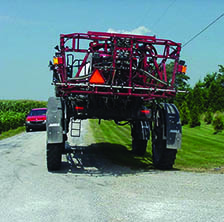
At the same time, farmers can also contribute to the risk. Consider that an average farm today may also own more vehicles, which are traveling to farms scattered over larger areas. Fatigued drivers often work long hours during spring planting and fall harvest moving equipment and supplies. And like all drivers, farmers have more distractions than ever with cell phones, GPS devices, and sophisticated electronic and computer systems required to operate their equipment.
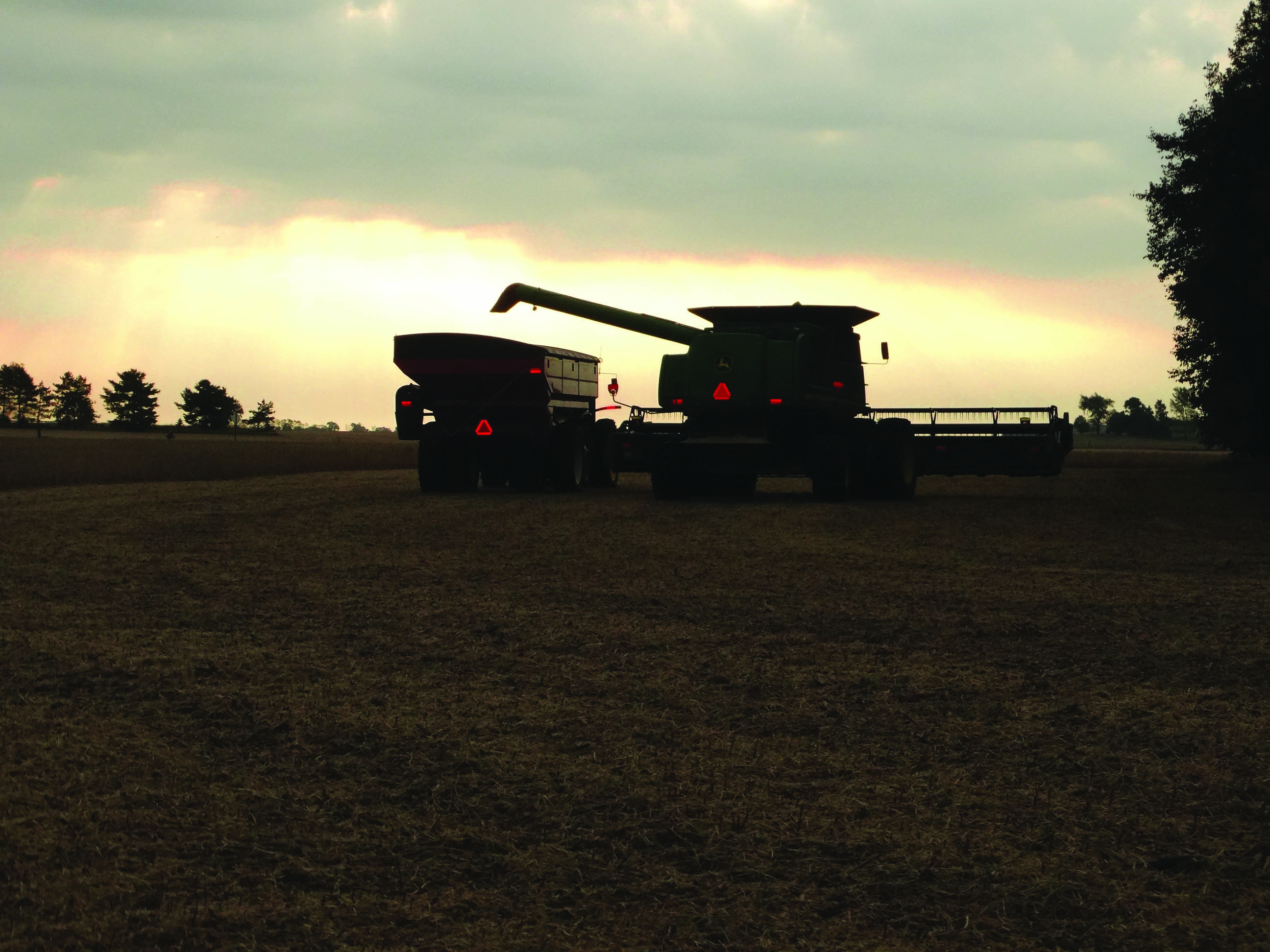

Night driving is dangerous for everyone on the highways. Anything you can do to make yourself visible can help prevent crashes.
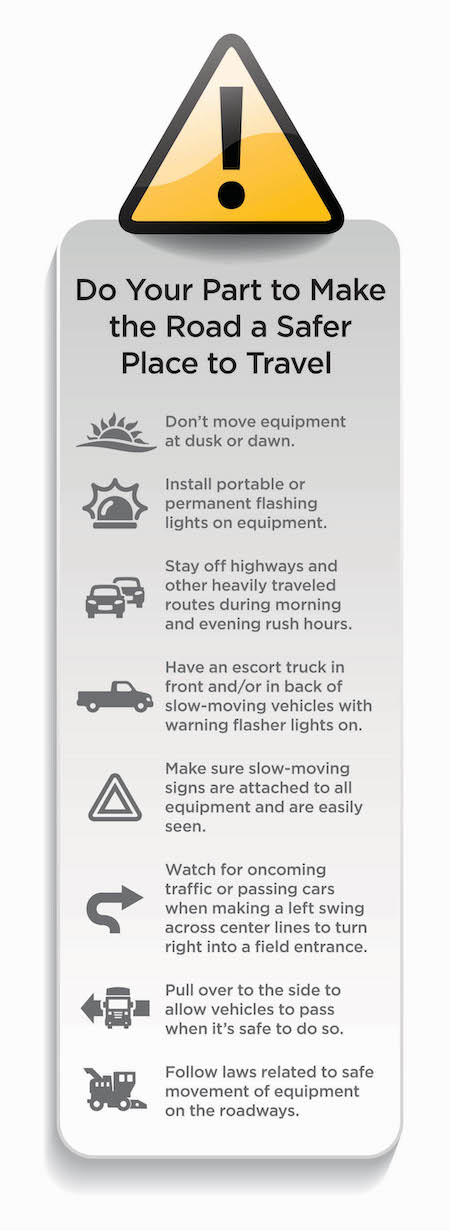
Lighter vehicles fold like accordions when they crash into heavier equipment. Serious traffic incidents can lead to insurance claims, lawsuits, out-of-court settlements, and jury verdicts that can reach hundreds of thousands of dollars. When human fatalities and permanent injuries are involved, farmers could face millions of dollars in liability exposure if they are found negligent. Such exposure potentially puts all farm assets at risk including property, equipment, and even the grain in the bins. The outcome of any legal proceeding can often be swayed by whether a farmer was following basic safety principles and the state and federal transportationregulations.
Consider a case where the driver of a car is killed after running a stop sign and getting struck on the passenger side by a farm semi-tractor loaded with corn.
Who’s at fault?
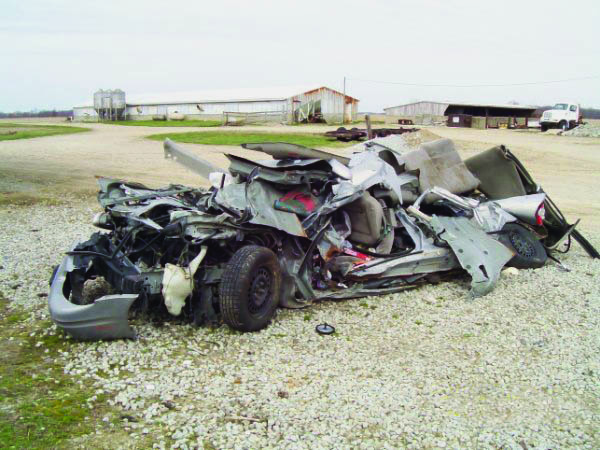

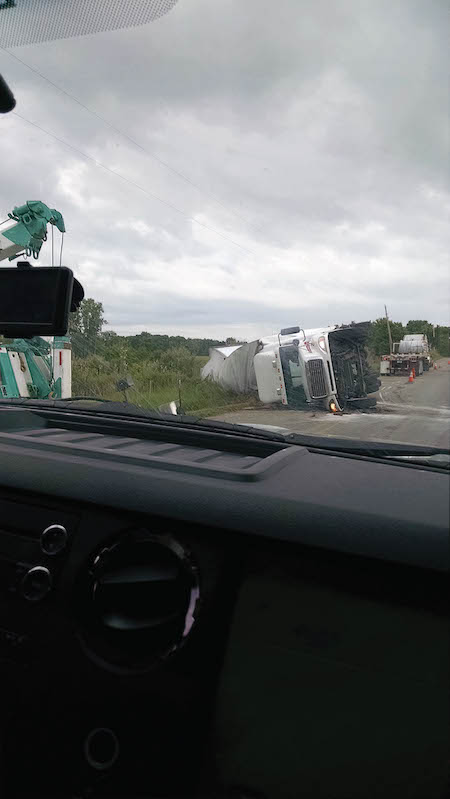
Most would say the driver who failed to stop at the stop sign would be 100 percent at fault. But the case would become more complicated if state investigators showed that the farm truck’s brakes were not working properly at the time of the collision, that the vehicle was overweight, that the farm driver was talking on a mobile phone, or that the farmer’s vision was impaired, or that drugs or alcohol were involved. Something as simple as a farm truck not having proper lighting could change the outcome of a case.
In this example, the attorney representing the car driver’s family may attempt to paint a mental picture for the jury. If the brakes on the farm truck had been working the way they were intended, the attorney may argue, the crash would not have been so severe or could have been avoided altogether. Possibly the driver would have survived.
Fair or not, the attorney is trying to make the farmer partially, if not wholly, responsible for the crash by focusing on faulty brakes. Conversely, this argument would have been more difficult to make to a jury or even impossible if the farmer is able to show regular maintenance records, to show that the truck was in good working order, and that both driver and vehicle complied with all regulations at the time of the collision.
Too often, farmers tend to focus on what they need to do to pass a random roadside inspection by a law enforcement officer. However, the real reason for following transportation regulations is to keep both farm equipment drivers and the public they share the road with safe from harm. From a liability standpoint, complying today is one way of defending yourself tomorrow if your truck or implement is involved in a crash.
Compliance With Transportation Regulations Made Easier
Farmers don’t have the time to read thousands of pages of transportation regulations to find the lines that apply to them. To make matters worse, regulations are not written in everyday language, which makes them difficult to read and even harder to interpret. Beyond the regulations, there are agency interpretative guidelines, administrative judge decisions, and appellate court decisions that can alter how regulations are interpreted, applied, and enforced.
Trying to integrate local, state, and federal regulations into a compliance program that passes enforcement reviews and legal analysis is more than just challenging — it’s really impossible for farmers who try to start from scratch. Even transportation consultants have difficulty creating comprehensive compliance programs, because regulations seem to be constantly updated or interpreted differently by enforcement officials.
Farmers should be able to get answers to the question: “What do I have to do to comply?” This guide will help Indiana farmers work their way through the maze of regulations that cover the transportation of farm equipment and supplies over public roads.At this point, it’s important to define “farmer” when it comes to transportation regulations.
The Code of Federal Regulations (49 CFR 390.5) defines a farmer as a private carrier — and a private carrier transports only its own goods and is not for hire. The definition of a farmer is what you would expect: someone who transports his or her own products to the marketplace or back to the farm to be stored; who hauls farm supplies such as fertilizers, pesticides, feed, and seed to the farm; and who transports farm equipment to be used on property he or she owns, rents or leases.
The Four Types of Carriers
If you are a farmer (and therefore a private carrier), then the four tables that follow will list the transportation regulations that apply to you. For this publication, we created four types of carriers. And the table for each type summarizes Indiana transportation regulations based on two main factors: whether you cross state lines and whether you travel on interstates.
Choose the statement that applies to you, and remember you should only be able to choose one statement.
- Table 1. You are an Indiana private carrier who never crosses state lines and never travels on interstate highways (page 10).
- Table 2. You are an Indiana private carrier who never crosses state lines but does travel on interstate highways (page 13).
- Table 3. You are an Indiana private carrier who crosses state lines but does not travel more than 150 air miles or 170 road miles from the farm (page 16).
- Table 4. You are an Indiana private carrier who crosses state lines and travels more than 150 air miles or 170 road miles from the farm (page 20).
The tables present regulations on all applicable topics. They also reference the specific state or federal codes that cover each rule.
The following recommendations are only intended for farmers who meet the definition of a private carrier.

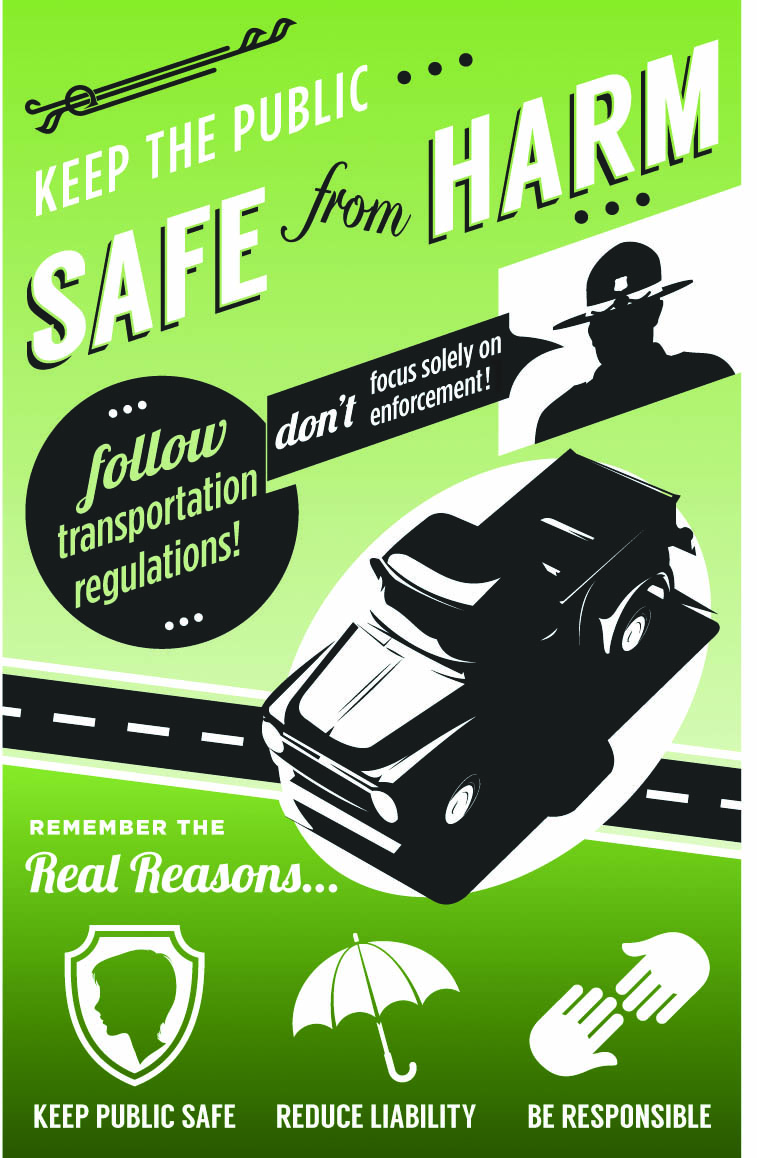



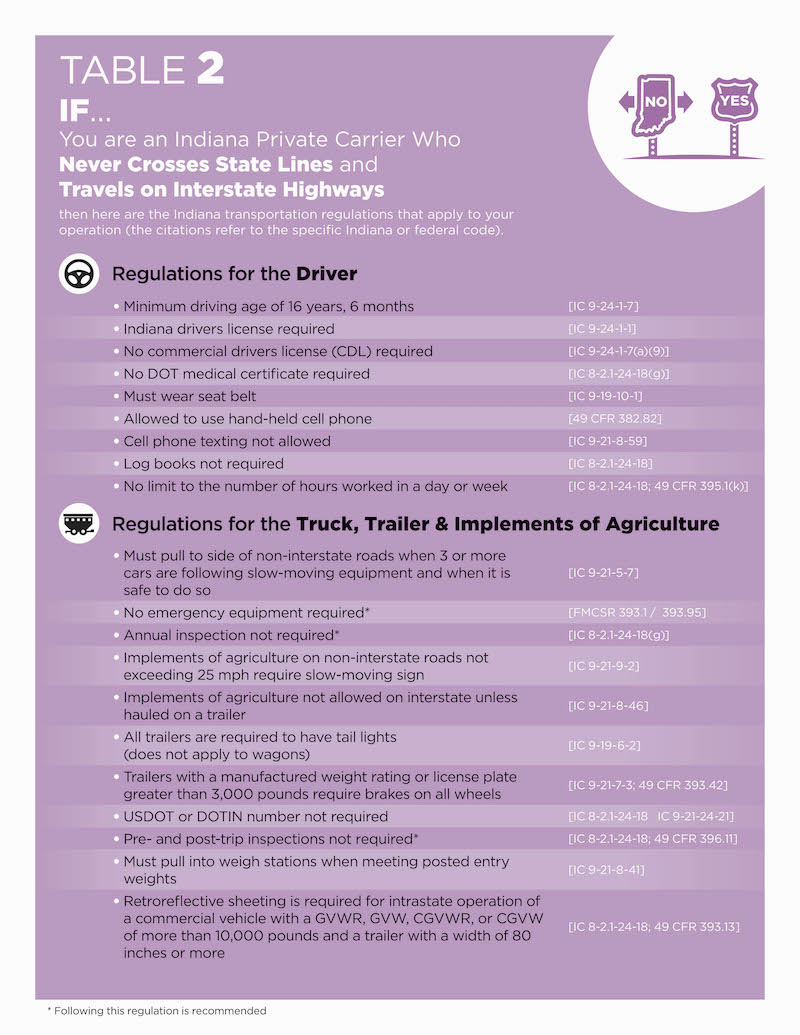
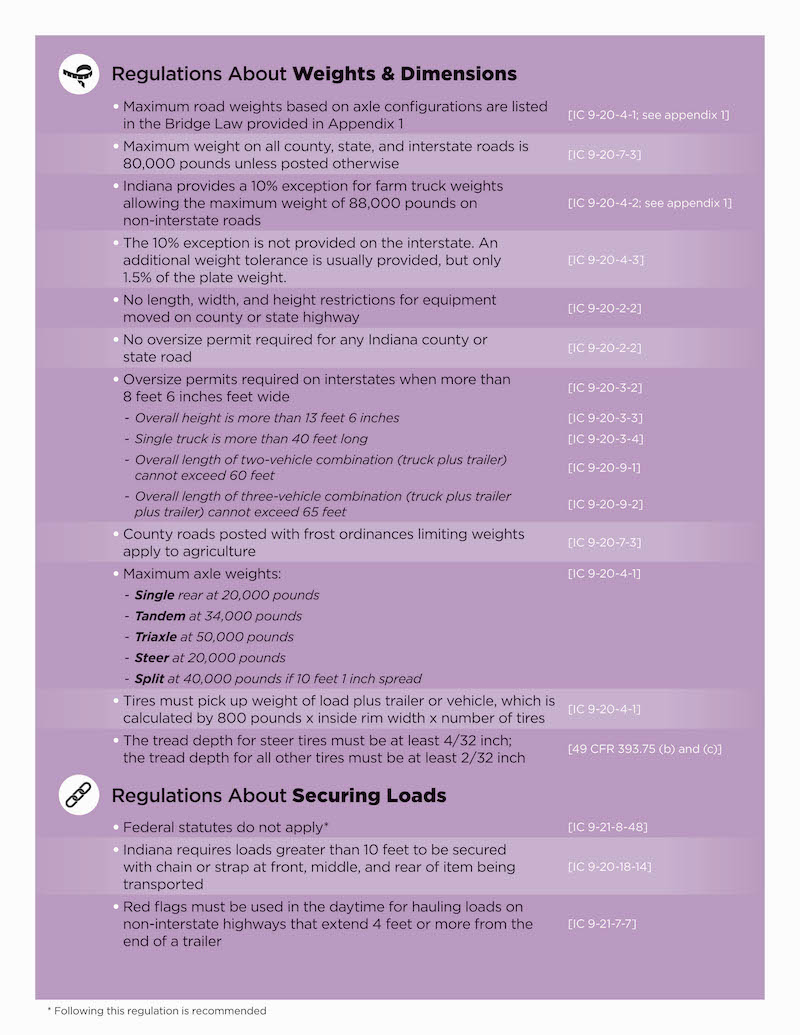
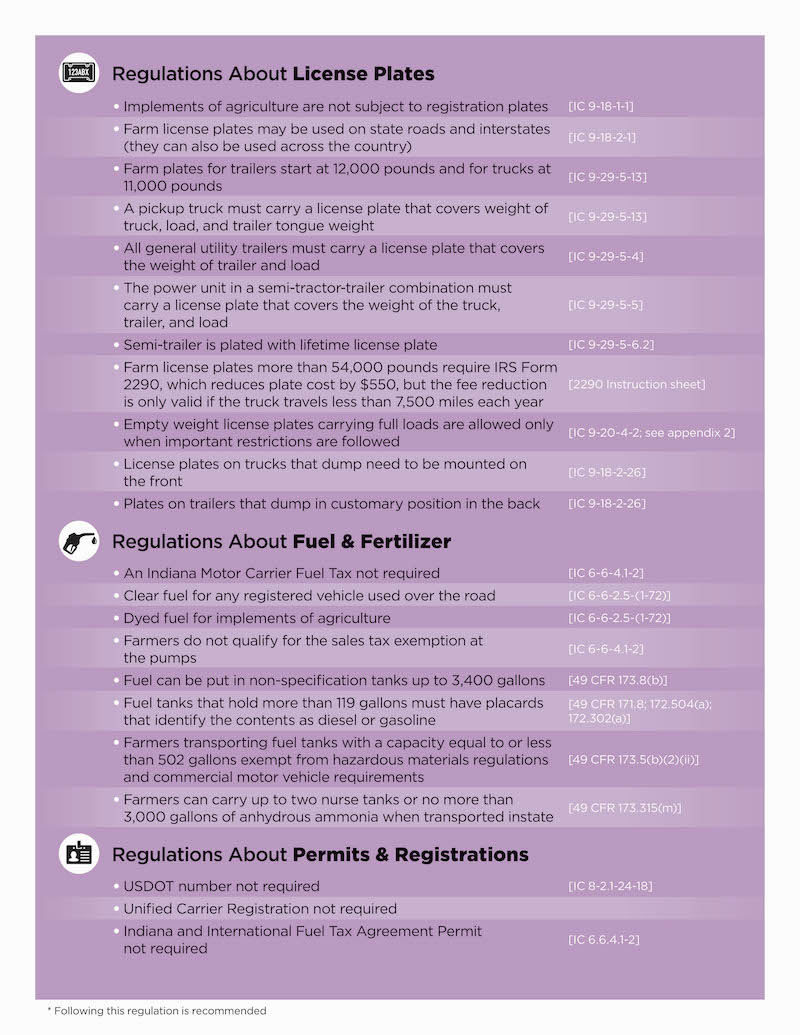
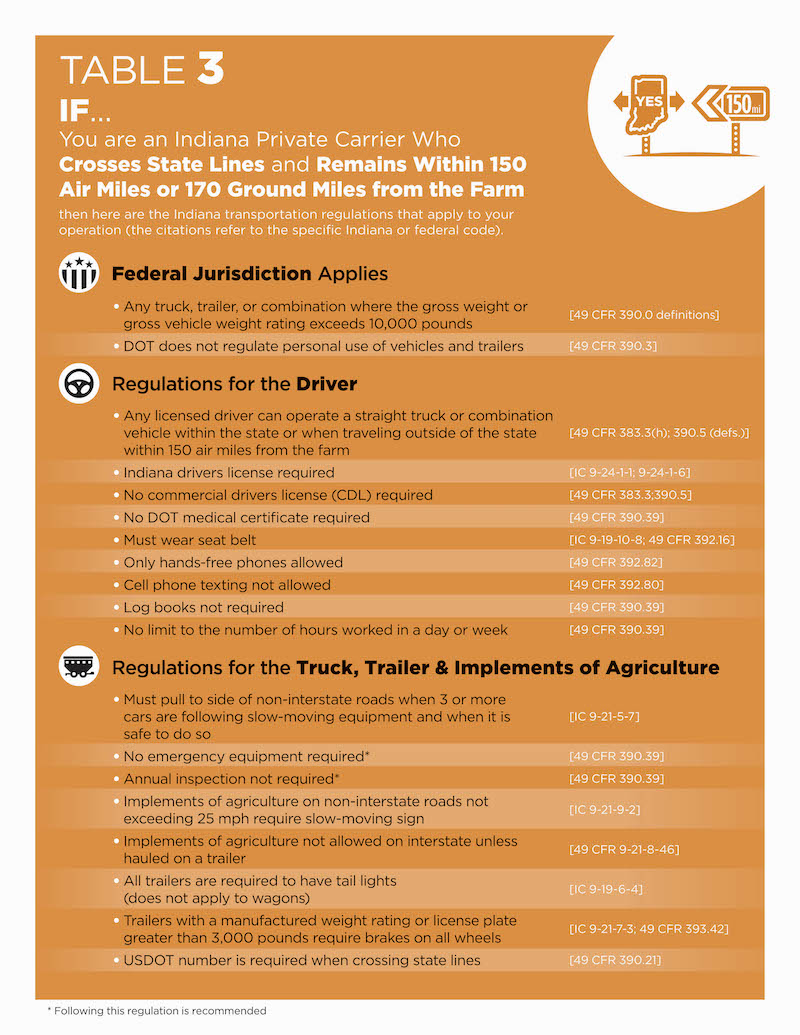



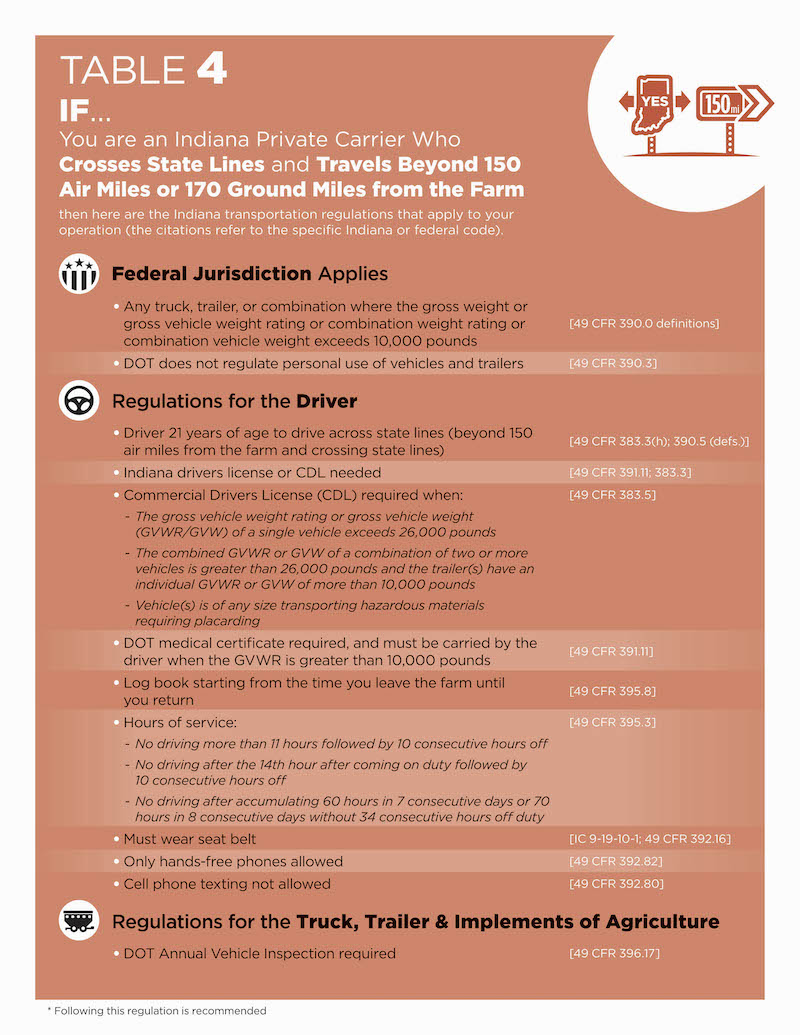

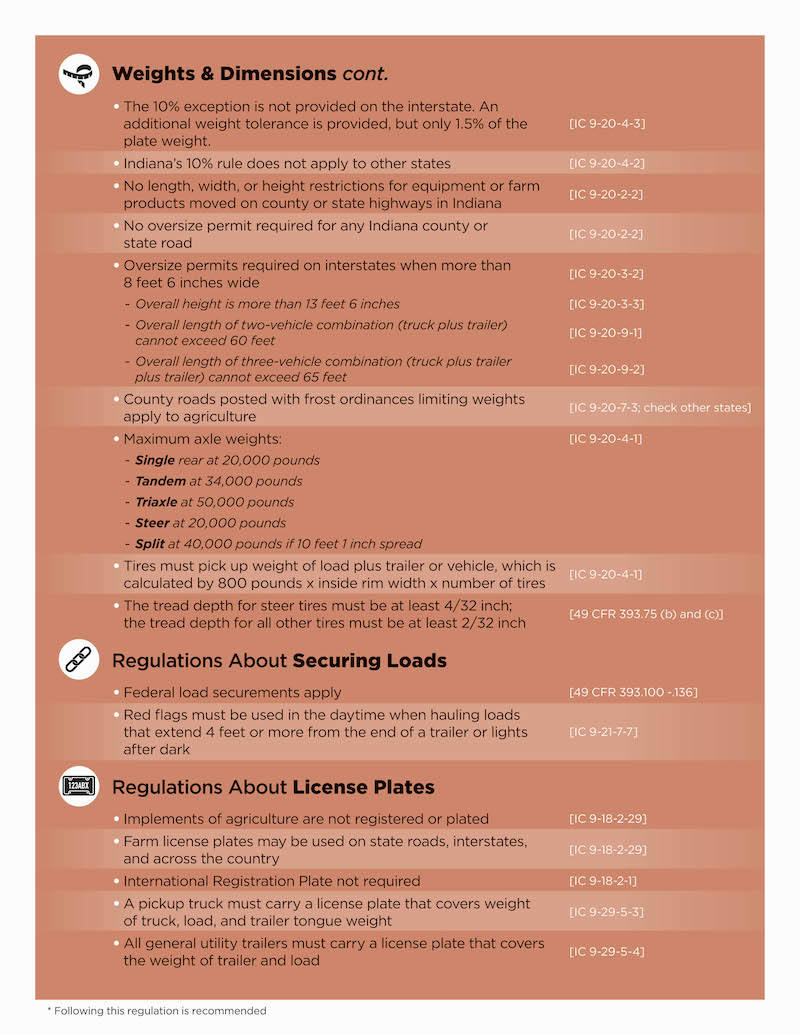
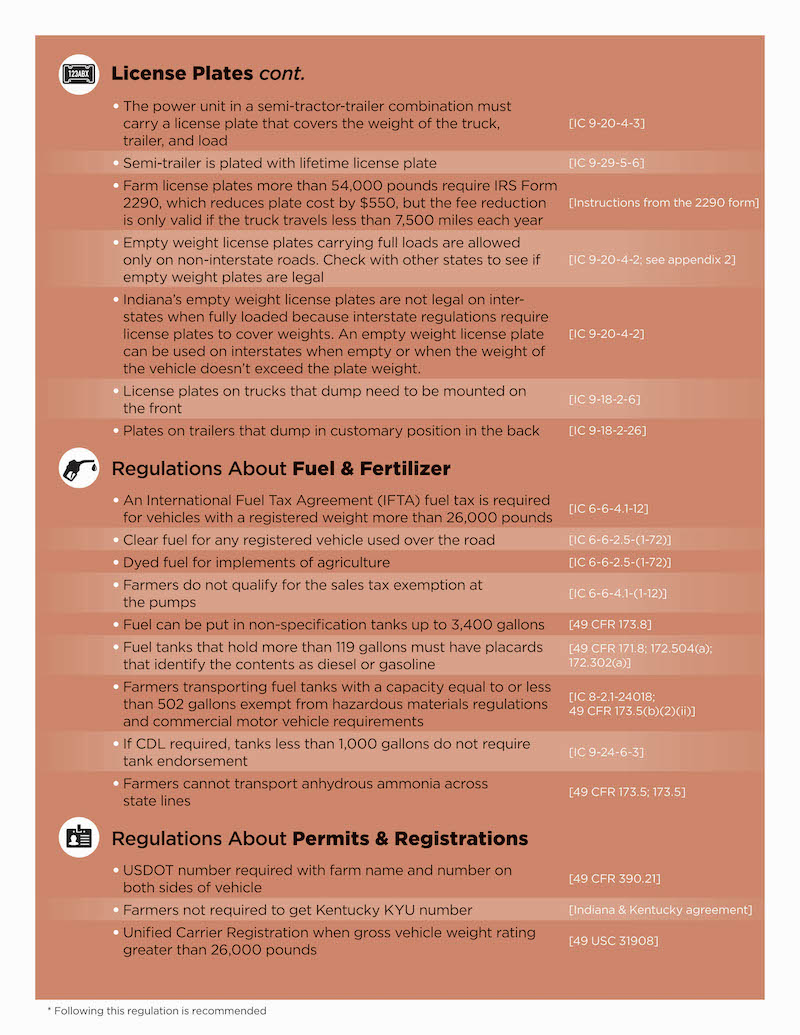
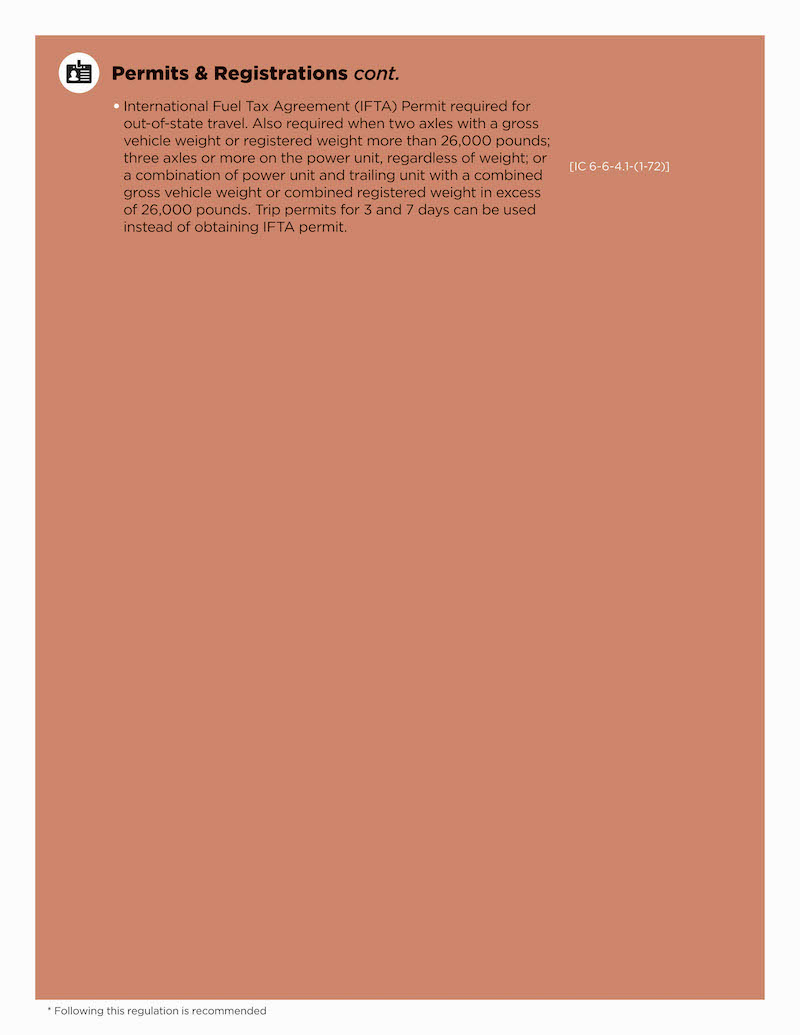

Conclusion
Farmers expect quick answers to what it takes for them to comply with transportation regulations. Because the regulations can be so complex, it probably takes more time asking questions about the farm’s operation than it takes providing the answers.
If you follow the guidelines in this publication, you should have a solid foundation to address what you might need to do as a farmer in order to comply with transportation regulations. However, regulations and laws change routinely — it is important that you continue to stay informed by asking questions of your peers, as well as state and federal enforce-ment officials.
CHECK FOR UPDATES
Regulations are always changing. And so are the interpretations of those regulations. We will keep up with these changes as much as possible on the Purdue Pesticide Programs website (ppp.purdue.edu). After reviewing this document, be sure to check the site for any changes and corrections under Purdue Extension publication PPP-111.
MOVING BEYOND THE REGULATIONS
“What I think is terribly important — as far as minimizing liability — is to be proactive and go beyond what the regulations require,” says Daniel Gwin, an Indiana farmer who operates several vehicles. “For me, that means that all my drivers have CDL licenses — and, by extension, also health cards. I think that’s important if I should ever have an accident — to show that I took steps to be sure my drivers were knowledgeable and certified by an outside party about their health and fitness and competency to operate a truck.
“I also have all of my trucks and trailers inspected by a certified mechanic, rather than sign off on them myself. Likewise, any mainte-nance and repair of critical systems such as brakes, steering, suspension, etc., is done by a certified mechanic. We might replace a head-lamp bulb or do some other incidental repair, but all critical system maintenance and repair is done by a certified mechanic shop and I keep records of all work done. I keep a separate file on each truck and trailer so that I can easily pull the records of the work that has been done with dates and receipts for payments on any piece of road equipment.
“Even if you’re not hauling out of state, keeping these records could be important if you ever are sued as a result of an accident. And, if you decide to start hauling out of state, you have a leg up on all the records, and you could take advantage of an opportunity very quickly without having to start from scratch.”
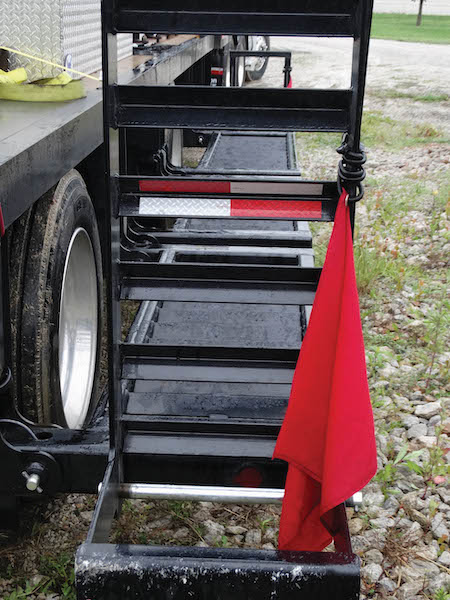 DISCLAIMER
DISCLAIMER
This publication is intended for educational purposes only. The au-thors’ views have not been approved by any government agency, business, or individual. The publication is distributed with the understanding that the authors are not rendering legal or other professional advice to the reader, and that the information contained herein should not be re-garded or relied upon as a substitute for professional consultation. The use of information contained herein constitutes an agreement to hold the authors, companies or review-ers harmless for liability, damage, or expense incurred as a result of reference to or reliance upon the information provided. Mention of a proprietary product or service does not constitute an endorsement by the authors or their employers. Descriptions of specific situations are included only as hypothetical case studies to assist readers of this publication, and are not intended to represent any actual person, busi-ness entity or situation. Reference in this publication to any specific commercial product, process, or service, or the use of any trade, firm, or corporation name is for general informational purposes only and does not constitute an endorsement, recommendation, or certification of any kind by Purdue University. Individuals using such products assume responsibility that the product is used in a way intended by the manufacturer and misuse is neither endorsed nor condoned by the authors nor the manufacturer.
APPENDIX 1: BRIDGE LAW

APPENDIX 2: INDIANA STATE POLICE LETTER
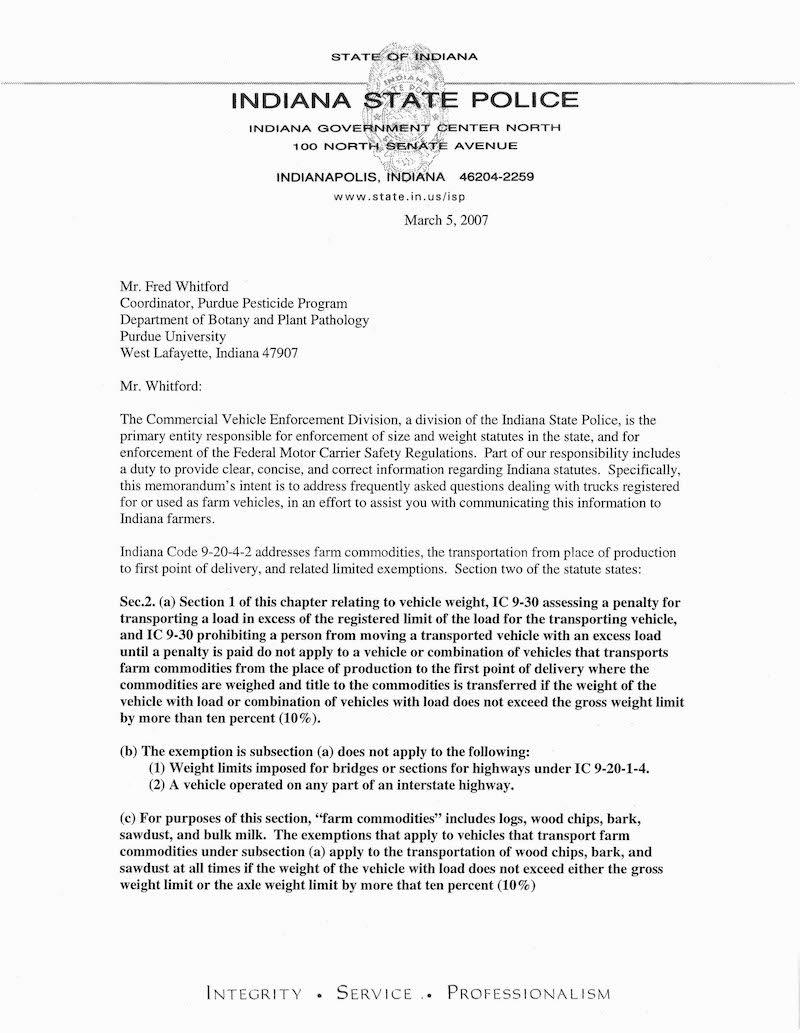
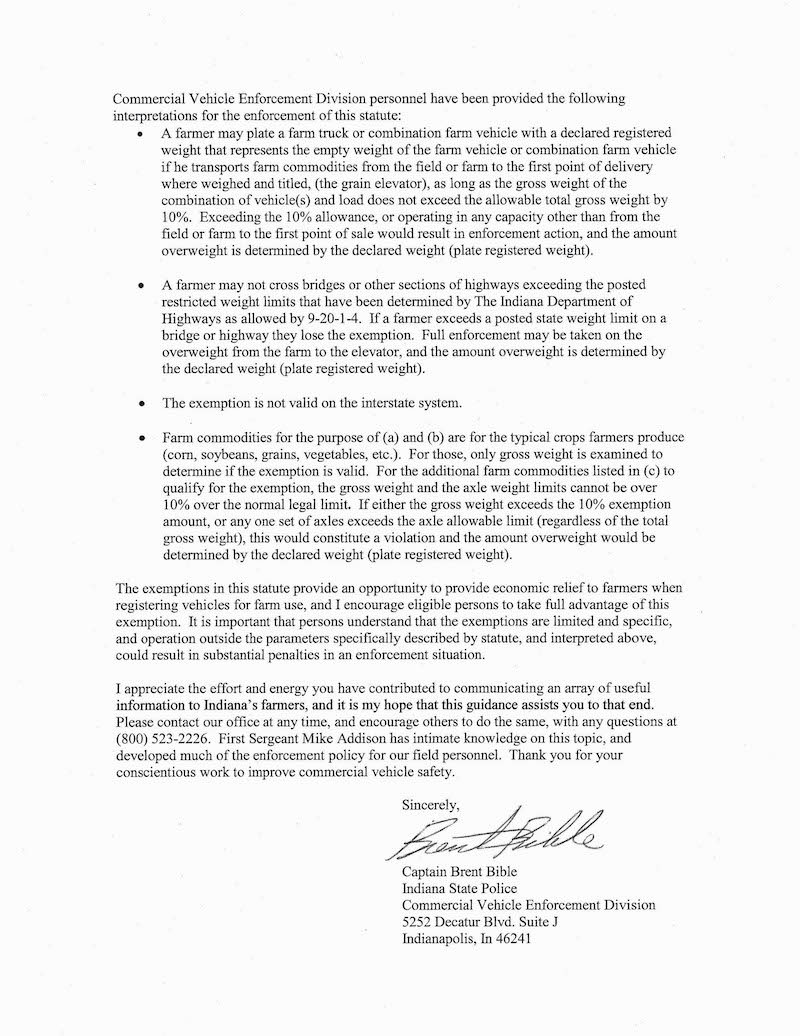
 The Aftermath of a Farm Truck Crash: Lawsuits, Settlements, and Court Proceedings (PPP-95). Learn more about what to do after your equipment is involved in a collision or crash.
The Aftermath of a Farm Truck Crash: Lawsuits, Settlements, and Court Proceedings (PPP-95). Learn more about what to do after your equipment is involved in a collision or crash. 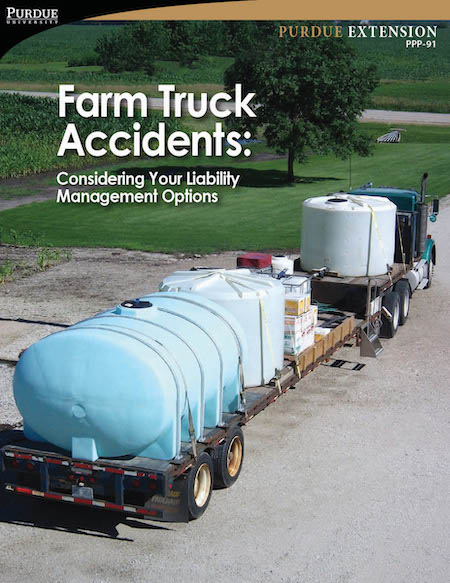 Farm Truck Accidents: Considering Your Liability Management Options (PPP-91). Take measures to reduce your over-the-road liabilities.
Farm Truck Accidents: Considering Your Liability Management Options (PPP-91). Take measures to reduce your over-the-road liabilities.  Transporting Farm Equipment:
What Growers Need to Know (PPP-83). Learn safe practices and your legal obligations for transporting equipment.
Transporting Farm Equipment:
What Growers Need to Know (PPP-83). Learn safe practices and your legal obligations for transporting equipment. 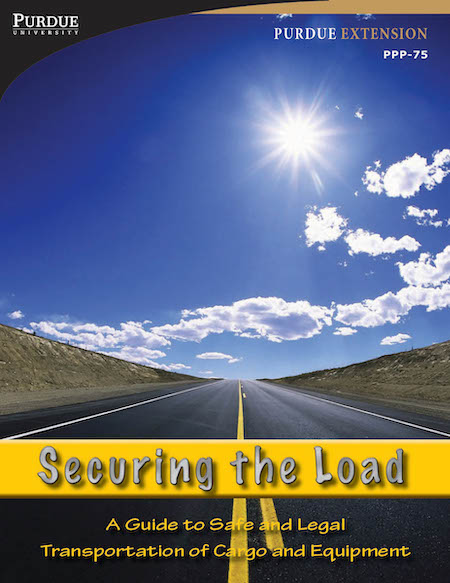 Securing the Load: A Guide to Safe and Legal Transportation of Cargo and Equipment (PPP-75). Keep gear safely secured to prevent accidents and stay legal.
Securing the Load: A Guide to Safe and Legal Transportation of Cargo and Equipment (PPP-75). Keep gear safely secured to prevent accidents and stay legal. 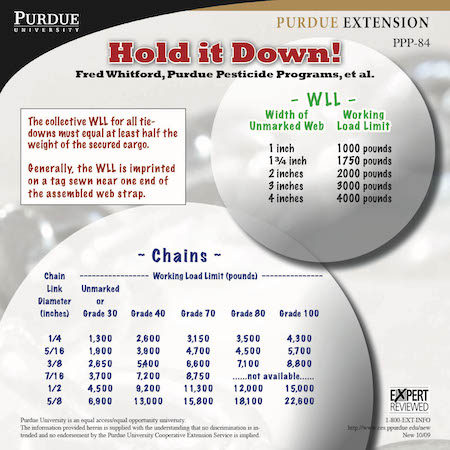 Hold it Down! (PPP-84). This laminated pocket guide is a companion to Securing the Load (PPP-75).
Hold it Down! (PPP-84). This laminated pocket guide is a companion to Securing the Load (PPP-75). 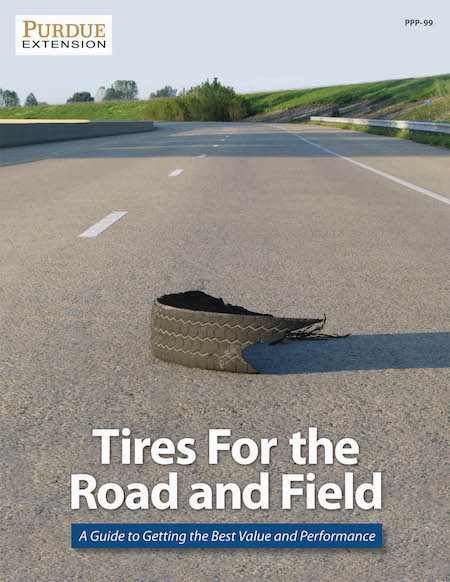 Tires For the Road and Field: A Guide to Getting the Best Value and Performance (PPP-99). Find the right replacement tires for your vehicles and operations.
Tires For the Road and Field: A Guide to Getting the Best Value and Performance (PPP-99). Find the right replacement tires for your vehicles and operations.  Keep the Trailer Connected to the Truck: Understanding the ‘Hitch’ System (PPP-92). Reduce your risks of losing a trailer or other equipment on a busy highway.
Keep the Trailer Connected to the Truck: Understanding the ‘Hitch’ System (PPP-92). Reduce your risks of losing a trailer or other equipment on a busy highway. 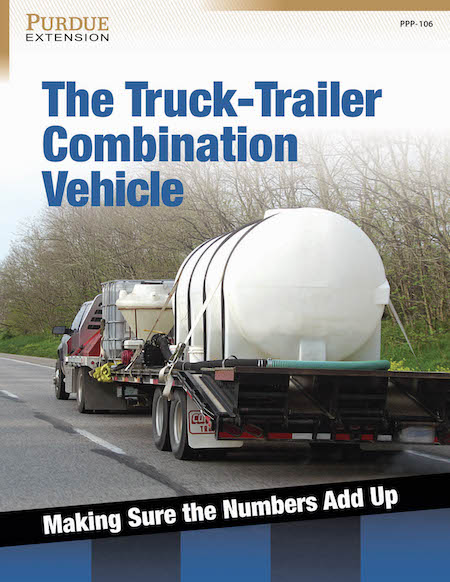 The Truck-Trailer Combination Vehicle: Making Sure the Numbers Add Up (PPP-106). Be certain all the parts work together to keep your truck-trailer combination operating safely.
The Truck-Trailer Combination Vehicle: Making Sure the Numbers Add Up (PPP-106). Be certain all the parts work together to keep your truck-trailer combination operating safely.  Order or download materials from Purdue Extension • The Education Store: edustore.purdue.edu
Order or download materials from Purdue Extension • The Education Store: edustore.purdue.edu
